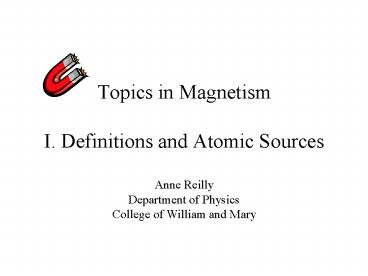Topics in Magnetism I. Definitions and Atomic Sources - PowerPoint PPT Presentation
Title:
Topics in Magnetism I. Definitions and Atomic Sources
Description:
Material from this lecture is taken from Physics of Magnetism by Chikazumi. and Solid State Physics by Ashcroft and Mermin (Chp. 31) Fundamental Definitions ... – PowerPoint PPT presentation
Number of Views:101
Avg rating:3.0/5.0
Title: Topics in Magnetism I. Definitions and Atomic Sources
1
Topics in MagnetismI. Definitions and Atomic
Sources
Anne Reilly Department of Physics College of
William and Mary
2
After reviewing this lecture, you should be
familiar with
1. Definitions of M, H and B 2. Magnetic units 3.
Atomic sources of magnetism 4. Paramagnetic and
Diamagnetic responses
Material from this lecture is taken from Physics
of Magnetism by Chikazumi and Solid State
Physics by Ashcroft and Mermin (Chp. 31)
3
Fundamental Definitions
Magnets have two poles (north and south) Poles
exert a force on each other
m1
m2
-m1
-m2
Definition magnetic pole m (SI unitsWeber,
Wbm2kg/s2A)
Magnetic force (N)
m04p x 10-7 H/m
4
Fundamental Definitions
Electric current in wire exerts a force on a
magnetic pole
H
I
m
-m
Definition magnetic field H (SI units A/m)
Magnetic force (N)
Field from Solenoid
n turns/m, I current
5
Fundamental Definitions
What happens to a magnet in a magnetic field?
mH
N
mH
-mH
l
q
S
N
H
H
S
-mH
Magnetic torque
Translational force ONLY if there is non-uniform
H (gradient)
6
Fundamental Definitions
mH
N
l
q
H
S
-mH
Definition magnetic moment M ml (SI units
Wb m)
(dipole moment)
Magnetic torque
Magnetic Energy
7
Fundamental Definitions
Magnetic materials have a density of magnetic
moments
Definition Magnetization MNM (SI units
Wb/m2 or Tesla T)
Nmoments per unit volume
N
M
S
8
Fundamental Definitions
To measure magnetization, use induction
(vibrating sample magnetometry)
H
M
B
V
Induced Voltage
Definition magnetic flux density B (SI units
Tesla T)
9
Fundamental Definitions
Magnetization in materials is proportional to
applied field H
Definition magnetic susceptibility c (SI units
H/m)
Definition magnetic permeability m (SI units
H/m)
10
Fundamental DefinitionsReview
H (externally applied)
M
B
M magnetization (T) H magnetic field strength
(A/m) B magnetic flux density (also called
field) (T)
11
Fundamental DefinitionsReview
Note that sometimes magnetic flux density is
defined as
In this case, the units of M are A/m
12
Gaussian System of Units
Common system prior to 1980s. Defined by
magnetic poles.
Oersted (Oe) CGS unit of magnetic field (H). The
Oersted is defined to be the field strength in a
vacuum at a distance 1 cm from a unit magnetic
pole. Gauss (G) CGS unit of magnetic flux
density (B). A field of one Gauss exerts a force
on a conductor of 0.1 dyne/A cm.
Electromagnetic Unit (emu) CGS unit of magnetic
dipole moment (M) equal to 1.256637 x 10-5 Oe.
emu/cm3 or emu/cc CGS unit of magnetization
(M) In SI units, one emu/cm3 can be interpreted
either as 1.256637 mT as a unit of excess
magnetic induction, or as 1000 A/m as a unit of
magnetic dipole moment per unit volume.
13
Unit Conversion
Gaussian unit (cgs-emu) Conversion (SI/cgs) SI unit
B Gauss (G) x 10-4 T or Wb/m2
H Oersted (Oe) x 103/4p A/m
M emu/cm3 x 103 x 4p/10 A/m mT
Note In free space (M0), 1 G 1 Oe
14
Source of Magnetic Moment Moving Electric Charge
(Current)
Atomic Magnetism arises from electron angular
momentum and spin
ML
ML orbital magnetic moment IA1/2 eL/me
r
I
v
L
15
Source of Magnetic Moment Moving Electric Charge
(Current)
Atomic Magnetism arises from electron angular
momentum and spin
ML
ML orbital magnetic moment IA1/2 eL/me
r
I
v
L
Atomic magnetic moment
Spin vector
Angular momentum vector
Bohr magneton
Gyromagnetic ratio ge 2
16
Source of Magnetic Moment Moving Electric Charge
(Current)
Multi-electron atoms total magnetic moment
determined by total J, L and S
- Hunds rules electrons fill shells such that
- Largest total S is achieved
- Largest total L is achieved
- JL-S (minimum) in shells less than half full
and JLS (maximum) in shells - more than half full.
17
Example
Maximum values L2210-1-22 S4/2 2 J4
18
Source of Magnetic Moment Quantum
Derivation (for multi-atom systems)
Magnetization Defined to be
(at T0)
(at Tgt0)
where
19
Source of Magnetic Moment Quantum
Derivation (for multi-atom systems)
In terms of Helmholtz free energy F
To calculate magnetic properites, consider
Hamiltonian in magnetic field and find energy
20
Source of Magnetic Moment Quantum Derivation
Write Hamiltonian for atomic electrons in a
Magnetic Field (ignore Vatom)
Vector potential
Consider first term
21
Source of Magnetic Moment Quantum Derivation
With
Consider first term
Using these relationships
22
Hamiltonian in a Magnetic Field
H
H0
Magnetic field dependent terms considered as
perturbation
23
Magnetic field as a perturbation
Energy (En is ground state energy)
24
Magnetic field as a perturbation
Energy (En is ground state energy)
paramagnetism
diamagnetism
25
In ground state atoms or ions with closed
(filled) shells
0
0
Larmor Diamagnetism is only response
26
Summary of magnetic responses
Diamagnetic (by Lenzs Law, opposes H)
cltlt1, negative
H
cltlt1, positive
paramagnetic (aligns with H)
BB
H
M
Mmagnetization
27
from http//www.geo.umn.edu
28
Summary of magnetic responses
diamagnetic (opposes H)
cltlt1, negative
H
cltlt1, positive
paramagnetic (aligns with H)
BB
H
M
ferromagnetic (even without H!)
cgt1, positive
BB
M































